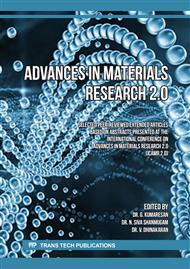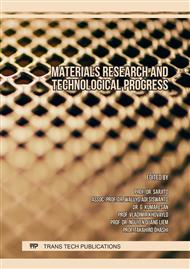[1]
P. Täubert, F. Thom, and U. Gammert, The lattice heat conductivity of aluminium alloys during age-hardening,, Cryogenics (Guildf)., vol. 13, no. 3, p.147–149, (1973).
DOI: 10.1016/0011-2275(73)90281-6
Google Scholar
[2]
A. L. Woodcraft, Predicting the thermal conductivity of aluminium alloys in the cryogenic to room temperature range,, Cryogenics (Guildf)., vol. 45, no. 6, p.421–431, (2005).
DOI: 10.1016/j.cryogenics.2005.02.003
Google Scholar
[3]
J. Tuttle, E. Canavan, and A. Jahromi, Cryogenic thermal conductivity measurements on candidate materials for space missions,, Cryogenics (Guildf)., vol. 88, p.36–43, (2017).
DOI: 10.1016/j.cryogenics.2017.10.010
Google Scholar
[4]
N. J. Vickers, Animal communication: when i'm calling you, will you answer too?,, Curr. Biol., vol. 27, no. 14, pp. R713–R715, (2017).
DOI: 10.1016/j.cub.2017.05.064
Google Scholar
[5]
Z. Weng, X. Xu, B. Yang, K. Gu, L. Chen, and J. Wang, Cryogenic thermal conductivity of 7050 aluminum alloy subjected to different heat treatments,, Cryogenics (Guildf)., vol. 116, p.103305, (2021).
DOI: 10.1016/j.cryogenics.2021.103305
Google Scholar
[6]
S. W. Choi et al., The effects of cooling rate and heat treatment on mechanical and thermal characteristics of Al–Si–Cu–Mg foundry alloys,, J. Alloys Compd., vol. 617, p.654–659, (2014).
DOI: 10.1016/j.jallcom.2014.08.033
Google Scholar
[7]
J. K. Chen, H. Y. Hung, C. F. Wang, and N. K. Tang, Effects of casting and heat treatment processes on the thermal conductivity of an Al-Si-Cu-Fe-Zn alloy,, Int. J. Heat Mass Transf., vol. 105, p.189–195, (2017).
DOI: 10.1016/j.ijheatmasstransfer.2016.09.090
Google Scholar
[8]
A. K. Padap, A. P. Yadav, P. Kumar, and N. Kumar, Effect of aging heat treatment and uniaxial compression on thermal behavior of 7075 aluminum alloy,, Mater. Today Proc., vol. 33, p.5442–5447, (2020).
DOI: 10.1016/j.matpr.2020.03.196
Google Scholar
[9]
K. Liu et al., Microstructural evolution and mechanical properties of deep cryogenic treated Cu–Al–Si alloy fabricated by Cold Metal Transfer (CMT) process,, Mater. Charact., vol. 159, p.110011, (2020).
DOI: 10.1016/j.matchar.2019.110011
Google Scholar
[10]
M. Araghchi, H. Mansouri, and R. Vafaei, Influence of cryogenic thermal treatment on mechanical properties of an Al–Cu–Mg alloy,, Mater. Sci. Technol., vol. 34, no. 4, p.468–472, (2018).
DOI: 10.1080/02670836.2017.1407553
Google Scholar
[11]
K. Gu, K. Wang, L. Chen, J. Guo, C. Cui, and J. Wang, Micro-plastic deformation behavior of Al-Zn-Mg-Cu alloy subjected to cryo-cycling treatment,, Mater. Sci. Eng. A, vol. 742, p.672–679, (2019).
DOI: 10.1016/j.msea.2018.05.033
Google Scholar
[12]
A. Bansal et al., Influence of cryogenic treatment on mechanical performance of friction stir Al-Zn-Cu alloy weldments,, J. Manuf. Process., vol. 56, p.43–53, (2020).
DOI: 10.1016/j.jmapro.2020.04.067
Google Scholar
[13]
C. Daqiang, Z. Yanbing, B. Hao, and Z. Huiming, Development and application of novel energy-savings material in steel industry,, (2009).
DOI: 10.1049/cp.2009.1390
Google Scholar
[14]
J. Li et al., Enhancement of fatigue properties of 2024-T351 aluminum alloy processed by cryogenic laser peening,, Vacuum, vol. 164, p.41–45, (2019).
DOI: 10.1016/j.vacuum.2019.02.030
Google Scholar
[15]
K. Gu, J. Wang, and Y. Zhou, Effect of cryogenic treatment on wear resistance of Ti–6Al–4V alloy for biomedical applications,, J. Mech. Behav. Biomed. Mater., vol. 30, p.131–139, (2014).
DOI: 10.1016/j.jmbbm.2013.11.003
Google Scholar
[16]
P. Täubert, F. Thom, and U. Gammert, The lattice heat conductivity of aluminium alloys during age-hardening,, Cryogenics (Guildf)., vol. 13, no. 3, p.147–149, (1973).
DOI: 10.1016/0011-2275(73)90281-6
Google Scholar
[17]
A. L. Woodcraft, Predicting the thermal conductivity of aluminium alloys in the cryogenic to room temperature range,, Cryogenics (Guildf)., vol. 45, no. 6, p.421–431, (2005).
DOI: 10.1016/j.cryogenics.2005.02.003
Google Scholar
[18]
J. Tuttle, E. Canavan, and A. Jahromi, Cryogenic thermal conductivity measurements on candidate materials for space missions,, Cryogenics (Guildf)., vol. 88, p.36–43, (2017).
DOI: 10.1016/j.cryogenics.2017.10.010
Google Scholar
[19]
N. J. Vickers, Animal communication: when i'm calling you, will you answer too?,, Curr. Biol., vol. 27, no. 14, pp. R713–R715, (2017).
DOI: 10.1016/j.cub.2017.05.064
Google Scholar
[20]
Z. Weng, X. Xu, B. Yang, K. Gu, L. Chen, and J. Wang, Cryogenic thermal conductivity of 7050 aluminum alloy subjected to different heat treatments,, Cryogenics (Guildf)., vol. 116, p.103305, (2021).
DOI: 10.1016/j.cryogenics.2021.103305
Google Scholar
[21]
S. W. Choi et al., The effects of cooling rate and heat treatment on mechanical and thermal characteristics of Al–Si–Cu–Mg foundry alloys,, J. Alloys Compd., vol. 617, p.654–659, (2014).
DOI: 10.1016/j.jallcom.2014.08.033
Google Scholar
[22]
J. K. Chen, H. Y. Hung, C. F. Wang, and N. K. Tang, Effects of casting and heat treatment processes on the thermal conductivity of an Al-Si-Cu-Fe-Zn alloy,, Int. J. Heat Mass Transf., vol. 105, p.189–195, (2017).
DOI: 10.1016/j.ijheatmasstransfer.2016.09.090
Google Scholar
[23]
A. K. Padap, A. P. Yadav, P. Kumar, and N. Kumar, Effect of aging heat treatment and uniaxial compression on thermal behavior of 7075 aluminum alloy,, Mater. Today Proc., vol. 33, p.5442–5447, (2020).
DOI: 10.1016/j.matpr.2020.03.196
Google Scholar
[24]
K. Liu et al., Microstructural evolution and mechanical properties of deep cryogenic treated Cu–Al–Si alloy fabricated by Cold Metal Transfer (CMT) process,, Mater. Charact., vol. 159, p.110011, (2020).
DOI: 10.1016/j.matchar.2019.110011
Google Scholar
[25]
M. Araghchi, H. Mansouri, and R. Vafaei, Influence of cryogenic thermal treatment on mechanical properties of an Al–Cu–Mg alloy,, Mater. Sci. Technol., vol. 34, no. 4, p.468–472, (2018).
DOI: 10.1080/02670836.2017.1407553
Google Scholar
[26]
K. Gu, K. Wang, L. Chen, J. Guo, C. Cui, and J. Wang, Micro-plastic deformation behavior of Al-Zn-Mg-Cu alloy subjected to cryo-cycling treatment,, Mater. Sci. Eng. A, vol. 742, p.672–679, (2019).
DOI: 10.1016/j.msea.2018.05.033
Google Scholar
[27]
A. Bansal et al., Influence of cryogenic treatment on mechanical performance of friction stir Al-Zn-Cu alloy weldments,, J. Manuf. Process., vol. 56, p.43–53, (2020).
DOI: 10.1016/j.jmapro.2020.04.067
Google Scholar
[28]
C. Daqiang, Z. Yanbing, B. Hao, and Z. Huiming, Development and application of novel energy-savings material in steel industry,, (2009).
DOI: 10.1049/cp.2009.1390
Google Scholar
[29]
J. Li et al., Enhancement of fatigue properties of 2024-T351 aluminum alloy processed by cryogenic laser peening,, Vacuum, vol. 164, p.41–45, (2019).
DOI: 10.1016/j.vacuum.2019.02.030
Google Scholar
[30]
K. Gu, J. Wang, and Y. Zhou, Effect of cryogenic treatment on wear resistance of Ti–6Al–4V alloy for biomedical applications,, J. Mech. Behav. Biomed. Mater., vol. 30, p.131–139, (2014).
DOI: 10.1016/j.jmbbm.2013.11.003
Google Scholar
[31]
P. Wikus, S. A. Hertel, S. W. Leman, K. A. McCarthy, S. M. Ojeda, and E. Figueroa-Feliciano, The electrical resistance and thermal conductivity of Ti 15V–3Cr–3Sn–3Al at cryogenic temperatures,, Cryogenics (Guildf)., vol. 51, no. 1, p.41–44, (2011).
DOI: 10.1016/j.cryogenics.2010.10.010
Google Scholar
[32]
L. Chen, H. Jin, J. Wang, Y. Zhou, W. Zhu, and Q. Zhou, 18.6 K single-stage high frequency multi-bypass coaxial pulse tube cryocooler,, Cryogenics (Guildf)., vol. 54, p.54–58, (2013).
DOI: 10.1016/j.cryogenics.2012.11.002
Google Scholar
[33]
L. W. Yang, Y. Q. Xun, G. Thummes, and J. T. Liang, Single-stage high frequency coaxial pulse tube cryocooler with base temperature below 30 K,, Cryogenics (Guildf)., vol. 50, no. 5, p.342–346, (2010).
DOI: 10.1016/j.cryogenics.2010.01.009
Google Scholar
[34]
B. Wang and Z. H. Gan, A critical review of liquid helium temperature high frequency pulse tube cryocoolers for space applications,, Prog. Aerosp. Sci., vol. 61, p.43–70, (2013).
DOI: 10.1016/j.paerosci.2013.05.001
Google Scholar
[35]
R. P. Reed and A. F. Clark, Materials at low temperatures,, Am. Soc. Met. 1983, p.590, (1983).
Google Scholar
[36]
Z. Weng, X. Liu, K. Gu, J. Guo, C. Cui, and J. Wang, Modification of residual stress and microstructure in aluminium alloy by cryogenic treatment,, Mater. Sci. Technol., vol. 36, no. 14, p.1547–1555, (2020).
DOI: 10.1080/02670836.2020.1800182
Google Scholar
[37]
R. N. Lumley, I. J. Polmear, H. Groot, and J. Ferrier, Thermal characteristics of heat-treated aluminum high-pressure die-castings,, Scr. Mater., vol. 58, no. 11, p.1006–1009, (2008).
DOI: 10.1016/j.scriptamat.2008.01.031
Google Scholar
[38]
Z. Zhang and K. H. Chen, Effect of solution heat-treating on electrical conductivity of Al-Zn-Mg-Cu aluminum alloy,, Mater. Sci. Eng. Powder Met., vol. 1, (2004).
Google Scholar
[39]
S. J. Zinkle and J. T. Busby, Structural materials for fission & fusion energy,, Mater. today, vol. 12, no. 11, p.12–19, (2009).
DOI: 10.1016/s1369-7021(09)70294-9
Google Scholar
[40]
S. Karabay, Modification of AA-6201 alloy for manufacturing of high conductivity and extra high conductivity wires with property of high tensile stress after artificial aging heat treatment for all-aluminium alloy conductors,, Mater. Des., vol. 27, no. 10, p.821–832, (2006).
DOI: 10.1016/j.matdes.2005.06.005
Google Scholar
[41]
Z. Zhang, J. Yu, and D. He, Effects of contact body temperature and holding time on the microstructure and mechanical properties of 7075 aluminum alloy in contact solid solution treatment,, J. Alloys Compd., vol. 823, p.153919, (2020).
DOI: 10.1016/j.jallcom.2020.153919
Google Scholar
[42]
I. S. Zuiko, S. Mironov, and R. Kaibyshev, Microstructural evolution and strengthening mechanisms operating during cryogenic rolling of solutionized Al-Cu-Mg alloy,, Mater. Sci. Eng. A, vol. 745, p.82–89, (2019).
DOI: 10.1016/j.msea.2018.12.103
Google Scholar
[43]
J. D. Robson, Microstructural evolution in aluminium alloy 7050 during processing,, Mater. Sci. Eng. A, vol. 382, no. 1–2, p.112–121, (2004).
DOI: 10.1016/j.msea.2004.05.006
Google Scholar
[44]
S. T. Lim, I. S. Eun, and S. W. Nam, Control of equilibrium phases (M, T, S) in the modified aluminum alloy 7175 for thick forging applications,, Mater. Trans., vol. 44, no. 1, p.181–187, (2003).
DOI: 10.2320/matertrans.44.181
Google Scholar
[45]
B. Baudouy, Low temperature thermal conductivity of aluminum alloy 1200,, Cryogenics (Guildf)., vol. 51, no. 11–12, p.617–620, (2011).
DOI: 10.1016/j.cryogenics.2011.09.002
Google Scholar



